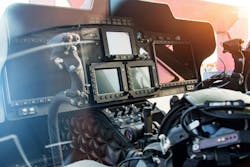Leidos to help Air Force defend crucial military avionics and sensors technologies from enemy cyber-attacks
WRIGHT-PATTERSON AFB, Ohio – U.S. Air Force researchers needed new ways to identify and mitigate vulnerabilities to avionics from cyber-attacks. They found a solution from Leidos Inc. in Reston, Va.
Officials of the Sensors Directorate of the Air Force Research laboratory at Wright-Patterson Air Force Base, Ohio, announced a $6.1 million contract to Leidos last month for the Radio Frequency (RF) Electronic Warfare (EW) Focused Laboratory Evaluations of Critical Technologies (REFLECT) program.
REFLECT also seeks to develop simulation capabilities necessary to develop advanced sensors and avionics technologies, develop agile electronics architecture, and expand emerging open-systems standards for military weapons. The goal is to explore new and emerging technologies related to fending-off cyber-attacks, cyber security, open system architectures, avionics, and sensors.
Leidos joins SRC Inc. in North Syracuse, N.Y.; and the BAE Systems Space & Mission Systems segment in Boulder, Colo. on the REFLECT program. SRC won a $60 million contract in April, and BAE Systems won a $30 million in June.
REFLECT avionics involve manned, unmanned, autonomous, and remotely piloted vehicles; on-board intelligence, surveillance, and reconnaissance (ISR) systems; EW systems, and munitions.
The specific focus is on advanced RF and digital EW simulations, threat models, sensor evaluations, and cutting-edge technology development in the RF domain.
For more information contact Leidos online at www.leidos.com; SRC at www.srcinc.com; BAE Systems Space & Mission Systems at www.baesystems.com/en-us/capability/space-systems, or the Air Force Research Laboratory at www.afrl.af.mil.
About the Author
John Keller
Editor-in-Chief
John Keller is the Editor-in-Chief, Military & Aerospace Electronics Magazine--provides extensive coverage and analysis of enabling electronics and optoelectronic technologies in military, space and commercial aviation applications. John has been a member of the Military & Aerospace Electronics staff since 1989 and chief editor since 1995.
